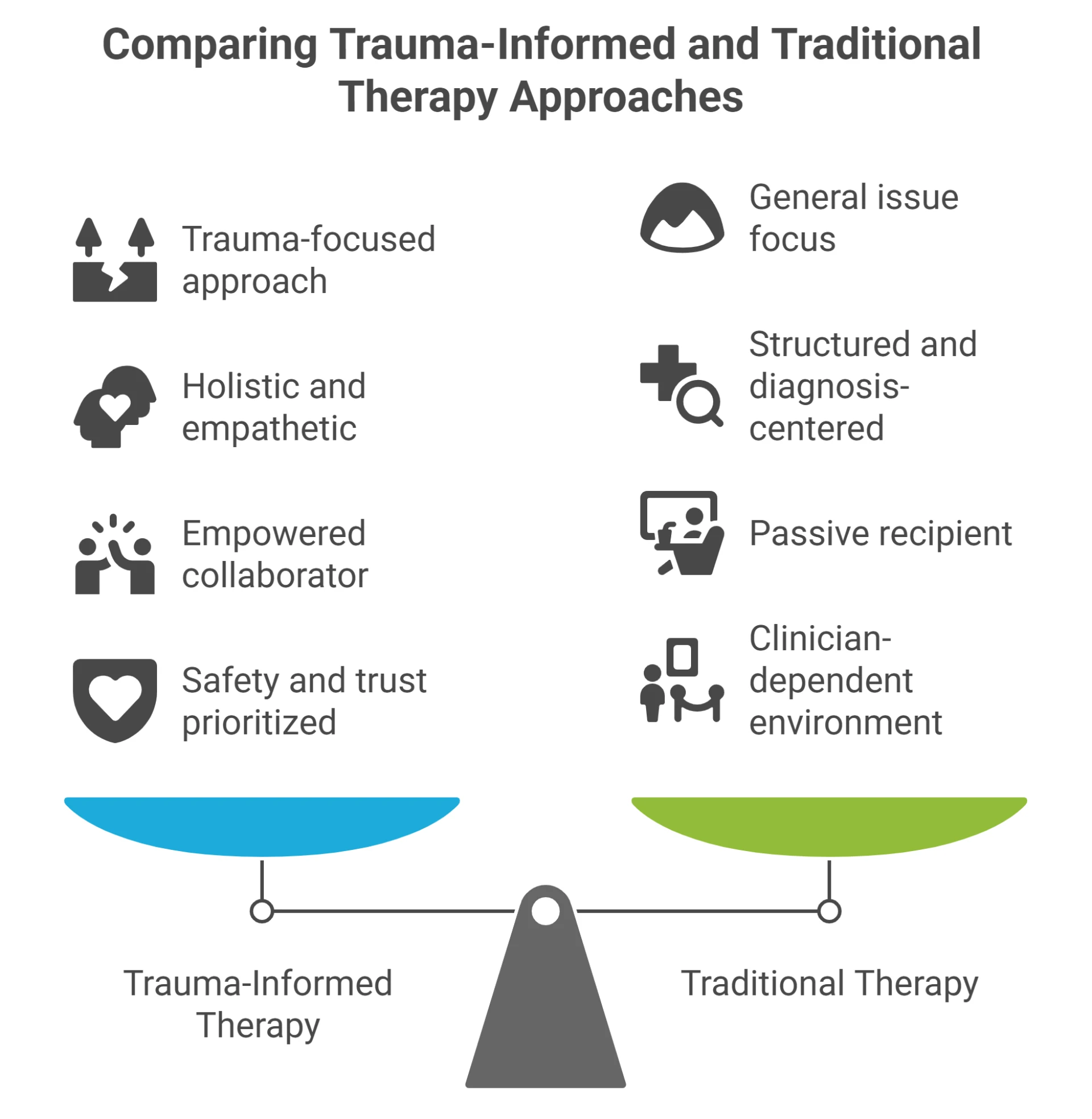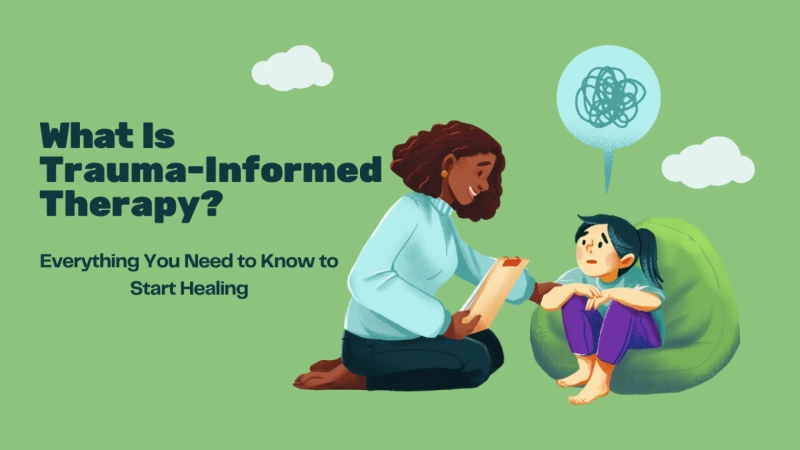Introduction to Trauma-Informed Therapy
Trauma-Informed Therapy is a holistic and evidence-based therapeutic approach that recognizes the widespread impact of trauma and seeks to create a safe, supportive environment for healing. Unlike traditional therapy, trauma-informed care centers on the understanding that past traumatic experiences can deeply influence an individual's current mental, emotional, and physical health.
This therapeutic model is not a specific technique or method, but rather a framework that can be integrated into various therapeutic practices. Mental health professionals who adopt a trauma-informed approach commit to viewing each client through the lens of compassion, sensitivity, and an awareness of trauma’s far-reaching effects.
The Core Principles of Trauma-Informed Care
According to the Substance Abuse and Mental Health Services Administration (SAMHSA), trauma-informed therapy is grounded in six core principles:
1. Safety
Creating an atmosphere where clients feel physically and emotionally safe is paramount.
2. Trustworthiness and Transparency
Therapists strive to build trust through clear, consistent communication and honesty.
3. Peer Support
Involving peer relationships to enhance healing and reinforce a sense of community.
4. Collaboration and Mutuality
Promoting equal partnerships between client and therapist.
5. Empowerment, Voice, and Choice
Encouraging clients to regain control of their lives through decision-making and empowerment.
6. Cultural, Historical, and Gender Sensitivity
Recognizing and addressing cultural and societal influences on trauma and healing.
Why Trauma-Informed Therapy Matters
Trauma is more common than many realize. Whether it’s childhood neglect, abuse, loss, violence, or chronic stress, trauma shapes how individuals perceive themselves and the world around them. When not properly addressed, trauma can contribute to a range of psychological disorders such as PTSD, anxiety, depression, addiction, and more.
Trauma-Informed Therapy is essential because it meets clients where they are, validating their experiences and focusing on resilience and recovery rather than pathology. This approach reduces re-traumatization and builds a therapeutic alliance that prioritizes healing and growth.
Key Differences Between Trauma-Informed and Traditional Therapy
While both trauma-informed and traditional therapies aim to support mental well-being, there are notable distinctions:

Who Can Benefit from Trauma-Informed Therapy?
Trauma-Informed Therapy is beneficial for individuals across a broad spectrum of backgrounds and experiences, including:
- Survivors of childhood abuse or neglect
- Victims of domestic violence
- Individuals with PTSD
- Refugees or displaced persons
- People who have experienced systemic oppression
- Anyone with a history of emotional or psychological trauma
Importantly, you don’t need a trauma “diagnosis” to benefit. Anyone seeking a compassionate, person-centered approach to therapy can gain from trauma-informed principles.
Common Techniques Used in Trauma-Informed Therapy
Trauma-informed therapists may use a variety of techniques, depending on the client’s needs and preferences. Common methods include:
1. Somatic Experiencing
Focuses on bodily sensations to help discharge trauma from the nervous system.
2. Eye Movement Desensitization and Reprocessing (EMDR)
Uses guided eye movements to help reprocess traumatic memories.
3. Cognitive Behavioral Therapy (CBT)
Helps clients identify and reframe negative thought patterns rooted in trauma.
4. Narrative Therapy
Encourages clients to tell their stories and reshape them in a healing way.
5. Mindfulness and Grounding Techniques
Teach presence and emotional regulation in moments of distress.
What to Expect in a Trauma-Informed Therapy Session
A trauma-informed therapy session typically differs from traditional approaches in both tone and structure. Clients can expect:
- A calm, welcoming environment
- Open-ended questions that avoid pressure or judgment
- The therapist prioritizing consent and collaboration
- Sessions that move at a pace comfortable for the client
- An emphasis on personal agency and emotional safety
These sessions are designed to ensure clients feel heard, respected, and never rushed into discussing traumatic events before they're ready.
How to Find a Trauma-Informed Therapist
Finding the right therapist is crucial for effective healing. Here are steps to help:
1.Search Trusted Directories: Use databases like Psychology Today or the National Register and filter by location and specialization in trauma-informed care.
2.Ask the Right Questions:
- Are you trained in trauma-informed care?
- What approaches or techniques do you use?
- How do you ensure client safety and empowerment?
3.Look for Credentials: Certifications in EMDR, somatic therapies, or trauma-focused CBT are good indicators.
4.Trust Your Instincts: The therapeutic relationship is key. If you don’t feel safe or supported, it’s okay to seek someone else.
Whether you're exploring options across the U.S. or specifically looking for Trauma Informed Therapy in Utah, finding a provider who aligns with your values and understands trauma’s complexities is essential to your healing journey.
Frequently Asked Questions
Q: Is trauma-informed therapy only for PTSD?
No. While it’s often used for PTSD, it can help anyone with unresolved emotional pain or adverse experiences.
Q: How long does trauma-informed therapy take?
It varies by individual. Some may benefit in months, while others may engage in longer-term care depending on their needs.
Q: Can trauma-informed therapy be done online?
Yes, many therapists now offer trauma-informed virtual sessions with the same sensitivity and care.
Final Thoughts
Trauma-Informed Therapy is a powerful, compassionate approach that places the individual’s safety, story, and strengths at the center of the healing process. By recognizing the deep impact of trauma and responding with empathy and evidence-based strategies, trauma-informed care helps individuals rebuild trust, reclaim control, and restore well-being.
If you or someone you know is struggling with the effects of trauma, reaching out to a trauma-informed therapist can be the first step toward meaningful healing.


